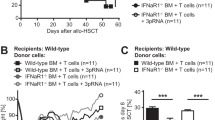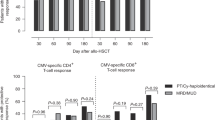Summary:
Delayed recovery of the immune system is a major cause of post-transplant infection. Natural interferon (IFN)-α/β-producing cells (IPC) appear to play a critical role in inducing effective immune responses to a variety of microbial pathogens by producing an enormous amount of IFN-α/β and thereafter by differentiating into dendritic cells. Here, we examined the recovery of IPC as well as other immune cells in 28 patients after allogeneic hematopoietic stem cell transplantation (HSCT) in order to investigate the role of IPC in post-transplant immune reconstitution. In uncomplicated cases, IPC frequency recovered to the lower range of normal values within 30 days after transplantation, resembling the prompt recovery of other cell types in innate immunity. In contrast, the recovery of IPC was profoundly suppressed in the cases with acute graft-versus-host disease (GVHD) and glucocorticoid administration. The patients with lower numbers of IPC were significantly more susceptible to viral infection. The prompt recovery of IPC in uncomplicated cases may contribute to establishing a first line of host defense at the early stage after allogeneic HSCT, whereas the marked suppression of IPC recovery accompanying acute GVHD and glucocorticoid administration may increase the risk of opportunistic infections.
This is a preview of subscription content, access via your institution
Access options
Subscribe to this journal
Receive 12 print issues and online access
$259.00 per year
only $21.58 per issue
Buy this article
- Purchase on Springer Link
- Instant access to full article PDF
Prices may be subject to local taxes which are calculated during checkout




Similar content being viewed by others
References
Parkman R, Weinberg KI . Immunological reconstitution following bone marrow transplantation. Immunol Rev 1997; 157: 73–78.
Mackall CL, Gress RE . Pathways of T-cell regeneration in mice and humans: implications for bone marrow transplantation and immunotherapy. Immunol Rev 1997; 157: 61–72.
Storek J, Gooley T, Witherspoon RP et al Infectious morbidity in long-term survivors of allogeneic marrow transplantation is associated with low CD4 T cell counts. Am J Hematol 1997; 54: 131–138.
Storek J, Espino G, Dawson MA et al Low B-cell and monocyte counts on day 80 are associated with high infection rates between days 100 and 365 after allogeneic marrow transplantation. Blood 2000; 96: 3290–3293.
Storek J, Dawson MA, Storer B et al. Immune reconstitution after allogeneic marrow transplantation compared with blood stem cell transplantation. Blood 2001; 97: 3380–3389.
Tayebi H, Tiberghien P, Ferrand C et al. Allogeneic peripheral blood stem cell transplantation results in less alteration of early T cell compartment homeostasis than bone marrow transplantation. Bone Marrow Transplant 2001; 27: 167–175.
Siegal FP, Kadowaki N, Shodell M et al. The nature of the principal type 1 interferon-producing cells in human blood. Science 1999; 284: 1835–1837.
Cella M, Jarrossay D, Facchetti F et al. Plasmacytoid monocytes migrate to inflamed lymph nodes and produce large amounts of type I interferon. Nat Med 1999; 5: 919–923.
Kadowaki N, Antonenko S, Liu YJ . Distinct CpG DNA and polyinosinic-polycytidylic acid double-stranded RNA, respectively, stimulate CD11c- Type 2 dendritic cell precursors and CD11c+ dendritic cells to produce Type I IFN. J Immunol 2001; 166: 2291–2295.
Rissoan M-C, Soumelis V, Kadowaki N et al. Reciprocal control of T helper cell and dendritic cell differentiation. Science 1999; 283: 1183–1186.
Kadowaki N, Antonenko S, Lau JY, Liu YJ . Natural interferon alpha/beta-producing cells link innate and adaptive immunity. J Exp Med 2000; 192: 219–226.
Siegal FP, Lopez C, Fitzgerald PA et al. Opportunistic infections in acquired immune deficiency syndrome result from synergistic defects of both the natural and adaptive components of cellular immunity. J Clin Invest 1986; 78: 115–123.
Soumelis V, Scott I, Gheyas F et al. Depletion of circulating natural type 1 interferon-producing cells in HIV-infected AIDS patients. Blood 2001; 98: 906–912.
Donaghy H, Pozniak A, Gazzard B et al. Loss of blood CD11c(+) myeloid and CD11c(-) plasmacytoid dendritic cells in patients with HIV-1 infection correlates with HIV-1 RNA virus load. Blood 2001; 98: 2574–2576.
Pacanowski J, Kahi S, Baillet M et al. Reduced blood CD123+ (lymphoid) and CD11c+ (myeloid) dendritic cell numbers in primary HIV-1 infection. Blood 2001; 98: 3016–3021.
Paloczi K . Immune reconstitution: an important component of a successful allogeneic transplantation. Immunol Lett 2000; 74: 177–181.
McCarthy NJ, Bishop MR . Nonmyeloablative allogeneic stem cell transplantation: early promise and limitations. Oncologist 2000; 5: 487–496.
Przepiorka D, Weisdorf D, Martin P et al. Consensus Conference on acute GVHD grading. Bone Marrow Transplant 1995; 15: 825–828.
Weinberg K, Blazar BR, Wagner JE et al. Factors affecting thymic function after allogeneic hematopoietic stem cell transplantation. Blood 2001; 97: 1458–1466.
Liu YJ . Dendritic cell subsets and lineages, and their functions in innate and adaptive immunity. Cell 2001; 106: 259–262.
Shodell M, Siegal FP . Corticosteroids depress IFN-alpha-producing plasmacytoid dendritic cells in human blood. J Allergy Clin Immunol 2001; 108: 446–448.
Pfeffer LM, Dinarello CA, Herberman RB et al. Biological properties of recombinant alpha-interferons: 40th anniversary of the discovery of interferons. Cancer Res 1998; 58: 2489–2499.
Muller U, Steinhoff U, Reis LF et al. Functional role of type I and type II interferons in antiviral defense. Science 1994; 264: 1918–1921.
Hale GA, Heslop HE, Krance RA et al. Adenovirus infection after pediatric bone marrow transplantation. Bone Marrow Transplant 1999; 23: 277–282.
Liu YJ, Kanzler H, Soumelis V, Gilliet M . Dendritic cell lineage, plasticity and cross-regulation. Nat Immunol 2001; 2: 585–589.
Fearnley DB, Whyte LF, Carnoutsos SA et al. Monitoring human blood dendritic cell numbers in normal individuals and in stem cell transplantation. Blood 1999; 93: 728–736.
Auffermann-Gretzinger S, Lossos IS, Vayntrub TA et al. Rapid establishment of dendritic cell chimerism in allogeneic hematopoietic cell transplant recipients. Blood 2002; 99: 1442–1448.
Klangsinsirikul P, Carter GI, Byrne JL et al. Campath-1G causes rapid depletion of circulating host dendritic cells (DCs) before allogeneic transplantation but does not delay donor DC reconstitution. Blood 2002; 99: 2586–2591.
Maury S, Mary JY, Rabian C et al. Prolonged immune deficiency following allogeneic stem cell transplantation: risk factors and complications in adult patients. Br J Haematol 2001; 115: 630–641.
Waller EK, Rosenthal H, Jones TW et al. Larger numbers of CD4(bright) dendritic cells in donor bone marrow are associated with increased relapse after allogeneic bone marrow transplantation. Blood 2001; 97: 2948–2956.
Arpinati M, Green CL, Heimfeld S et al. Granulocyte-colony stimulating factor mobilizes T helper 2-inducing dendritic cells. Blood 2000; 95: 2484–2490.
Acknowledgements
We thank Dr Yong-Jun Liu (DNAX Research Institute) for HSV-1. This work was supported by a research grant from the Ministry of Education, Culture, Sports, Science and Technology, Japan.
Author information
Authors and Affiliations
Rights and permissions
About this article
Cite this article
Kitawaki, T., Kadowaki, N., Ishikawa, T. et al. Compromised recovery of natural interferon-α/β-producing cells after allogeneic hematopoietic stem cell transplantation complicated by acute graft-versus-host disease and glucocorticoid administration. Bone Marrow Transplant 32, 187–194 (2003). https://doi.org/10.1038/sj.bmt.1704093
Received:
Accepted:
Published:
Issue Date:
DOI: https://doi.org/10.1038/sj.bmt.1704093
Keywords
This article is cited by
-
Plasmacytoid dendritic cells in allogeneic hematopoietic cell transplantation: benefit or burden?
Bone Marrow Transplantation (2016)
-
Clinical significance of subcategory and severity of chronic graft-versus-host disease evaluated by National Institutes of Health consensus criteria
International Journal of Hematology (2011)
-
Mycophenolate mofetil combined with tacrolimus and minidose methotrexate after unrelated donor bone marrow transplantation with reduced-intensity conditioning
International Journal of Hematology (2009)
-
Circulating dendritic cell subset levels after allogeneic stem cell transplantation in children correlate with time post transplant and severity of acute graft-versus-host disease
Bone Marrow Transplantation (2005)



